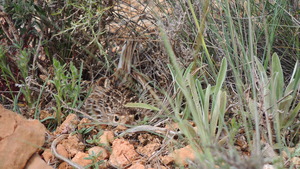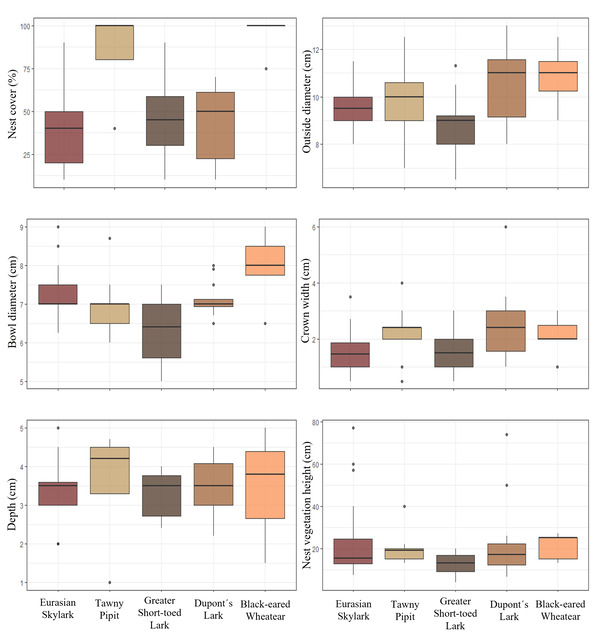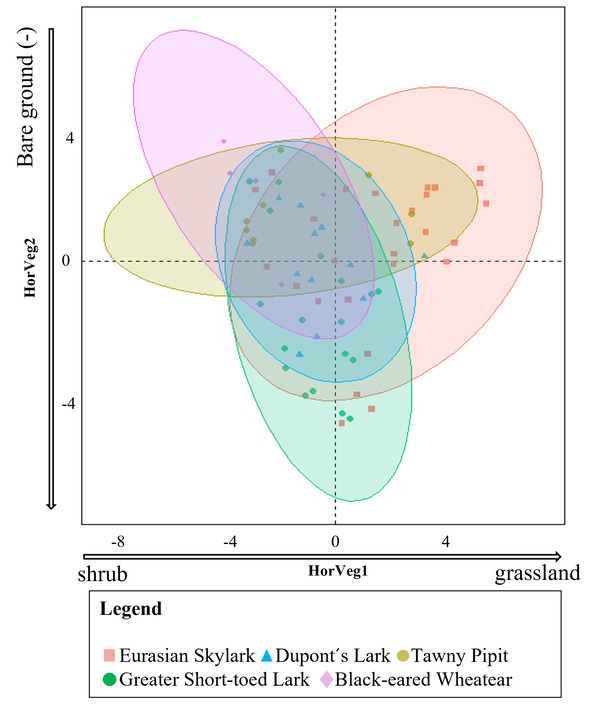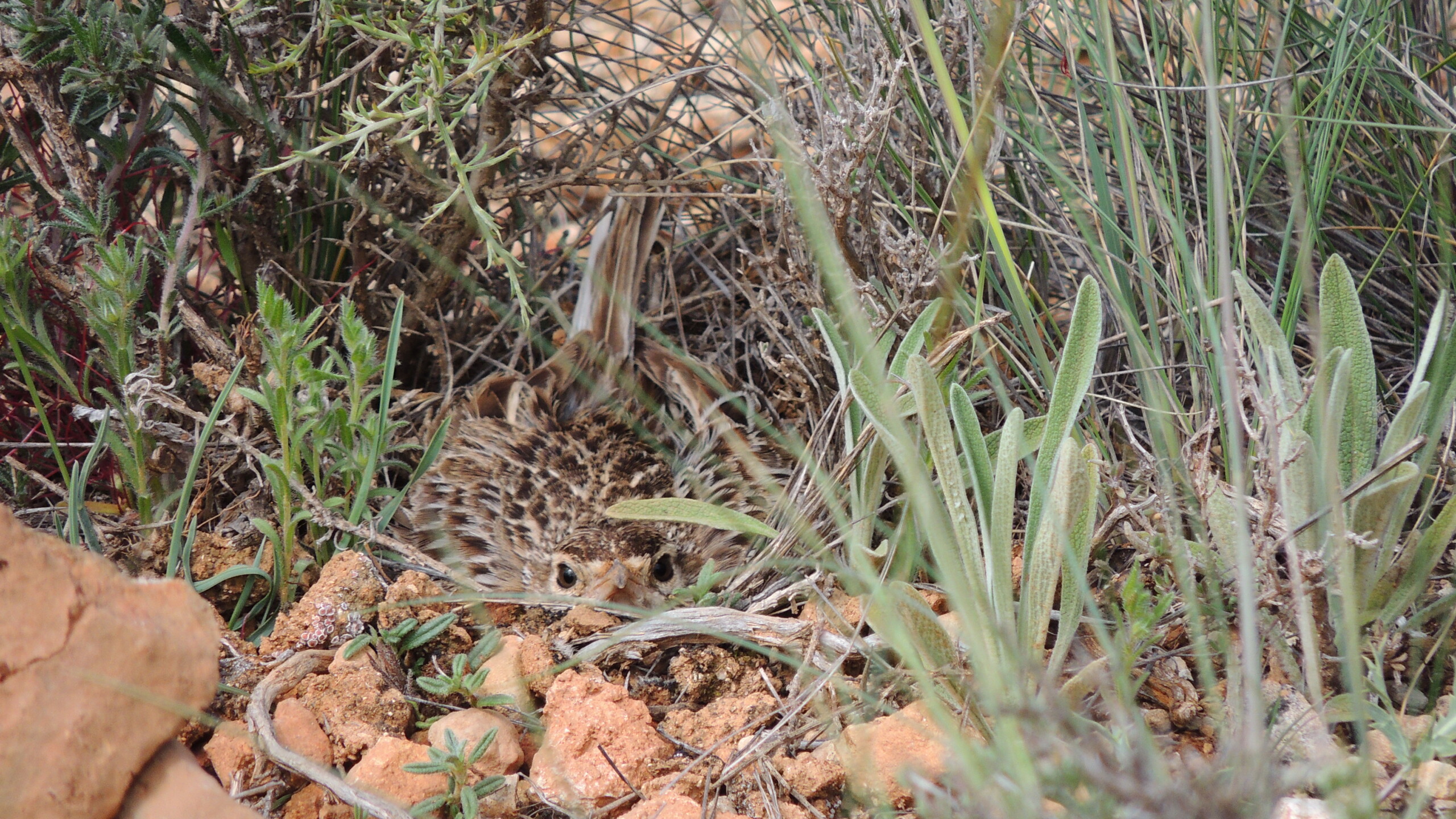 LINKED PAPER
LINKED PAPER
Nest Features and Nesting Niche Segregation in Five Iberian Steppe Passerines. Barrero, A., Caballero, B. C., Reverter, M., Gómez-Catasús, J., Bustillo-de la Rosa, D., Zurdo, J., & Traba, J. 2023 Ardeola. doi: 10.13157/arla.70.2.2023.ra4 VIEW
Shrub-steppe passerines such as Dupont’s Lark (Chersophilus duponti), Eurasian Skylark (Alauda arvensis), Greater Short-toed Lark (Calandrella brachydactyla), Tawny Pipit (Anthus campestris) and Black-eared Wheatear (Oenanthe melanoleuca) have unique ecological and evolutionary characteristics related to their preference for structurally simple habitats. This fact could restrict their nesting sites, as most of these species place their nests on the ground and more or less covered by vegetation, which may make this group of birds particularly sensitive during competition with other sympatric species when choosing a suitable nest site.
Nest site selection refers to species-specific preferences for nest location and is constrained by the evolutionary history of birds, which determines the distribution of species in micro- and macrohabitats (Brightsmith 2005). Nesting requirements can be considered components of a species’ niche, so that in areas where similar bird species coexist, there should be differential selection at the microhabitat scale for the nest site, usually in relation to the building materials, shape and nest structure, as well as the vegetation structure of the chosen site (Collias & Collias 2014).
We already know that these coexisting species have a high degree of diet overlap (Zurdo et al. 2023) and identified the Eurasian Skylark as the dominant species modulating the community (Barrero et al. 2022).
Do similar bird species nest differently?
To answer this question, we monitored and measured 79 nests between 2017 and 2019 in central Spain. We evaluated differences in nest structure and nesting microhabitats between five coexistent steppe passerines, to check if nesting niche segregation occurs, which may facilitate their coexistence.
All species built their nests under short vegetation (< 20 cm) and with similar nest depth; however, we found strong differences between species for some of the variables considered including: nest cover, outer nest diameter, bowl diameter and crown width. For example, the three lark species (Eurasian Skylark, Dupont’s Lark and Greater Short-toed Lark) built their nests in areas with less vegetation cover than Tawny Pipit and Black-eared Wheatear. Nest structure characteristics have been described as a virtually unmodifiable innate instinctive activity and construction strategies are possibly a general rule based on phylogenetic differences. Therefore, interspecific differences in nest structure observed in our study, beyond their purely descriptive value, should not be interpreted as part of the niche segregation process.

Figure 1 Differences in the descriptor variables characterising the nest structure of the different species: nest cover, outer nest diameter, bowl diameter, crown width, depth and nest vegetation height. Box plots show medians, 25th and 75th percentiles and outliers.
However, our results showed the existence of partial nesting niche segregation at the microhabitat scale among some of the species. The Eurasian Skylark presented differential requirements than the other species, as it nested in areas dominated by herbaceous vegetation. On the contrary, all other species showed nesting preferences for shrubby areas dominated by camephytes, and the Greater Short-toed Lark nested in intermediate areas with a high proportion of bare ground, thus showing a certain degree of segregation too. Dupont’s Lark, Tawny Pipit and Black-eared Wheatear showed similarities in nest site requirements, both in terms of horizontal and vertical vegetation structure. This could lead to negative biotic interactions between them when competing for nest sites, which will depend on the degree of competition intensity linked to the different abundances of these species.

Figure 2 Scatter plot of nests of each species along both gradients extracted by the PCA on the horizontal vegetation structure: the shrubland and grassland gradient on the abscissa axis was negatively associated with shrub cover and positively associated with herbaceous cover, and the bare ground gradient on the ordinate axis, was negatively associated with bare ground.
In summary, this study has demonstrated differences in nest structure and nest niche between ecologically similar species, which appear to partially segregate through different nest location patterns when living in sympatry. These results suggest that the interspecific differences found in the nesting microhabitat niche of some of the species studied may have facilitated coexistence over evolutionary time in a dynamic and interactive context, as they contribute to reducing competition for resources.

Figure 3 Scheme explaining the variation in nest placement in a gradient from mainly herbaceous to mainly shrub cover with species located according to their preferred nesting habitat characteristics. Image A corresponds to an area dominated by herbaceous vegetation. Image B correspond to an area located in the middle of the gradient with a predominance of bare ground. C would correspond to a nest located in an area with more shrub cover © Daniel Bustillo.
References
Barrero, A., Ovaskainen, O., Traba, J. & Gómez-Catasús, J. 2023. Co-occurrence patterns in a steppe bird community: insights into the role of dominance and competition. Oikos e09780. VIEW
Brightsmith, D.J. 2005. Competition, predation and nest niche shifts among tropical cavity nesters: ecological evidence. Journal of Avian Biology 36: 74-83. VIEW
Collias, N.E. & Collias, E.C. 2014. How birds build their nests. In, Nest Building and Bird Behavior, pp. 164-189. Princeton University Press.
Zurdo, J., Barrero, A., da Silva, l.P., Bustillo de la rosa, D., Gómez-Catasús, J., Morales, M.B., Traba, J. & Mata, V.A. 2023. Dietary niche overlap and resource partitioning among six steppe passerines of Central Spain using DNA metabarcoding. Ibis. VIEW
Image credit
Top right: Dupont’s Lark in nest © Adrián Barrero.
If you want to write about your research in #theBOUblog, then please see here.





